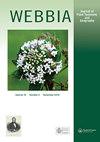Five pollination guilds of aroids (Araceae) at Mulu National Park (Sarawak, Malaysian Borneo)
Q3 Agricultural and Biological Sciences
引用次数: 12
Abstract
ABSTRACT This study aimed to investigate the floral biology and pollinators of 21 aroid species representing 10 genera at Mulu National Park to ascertain if additional guilds were active in this, one of the most florally diverse plant families in the tropics. Extensive field observations on floral biology, including inflorescence development stages, floral traits, and pollinator rewards, identification of pollinators and their behaviour(s), were undertaken. Reproductive success was calculated and compared among taxa. Anthetic duration of unisexual-flowered taxa was 1–4 days, compared with 4–18 days in bisexual-flowered taxa. Floral traits such as floral odour, restricted access to the female zone during pistillate anthesis, presence of sacrificial floral tissues and anthetic duration affected the type and number of pollinators. Diptera are the most likely pollinators for Aglaonema, Alocasia, Pothos and species of Schismatoglottideae; Coleoptera are the pollinators for Amorphophallus, Anadendrum (together with thrips), Homalomena, Lasia and Schismatoglottis; Thysanoptera (thrips) is one of the pollinators for Anadendrum; Hemiptera (Miridae) pollinates Lasia spinosa and Pothos insignis. Hymenoptera (Apidae) are pollinators for Alocasia sarawakensis and Amorphophallus hewittii. Alocasia sarawakensis, Amorphophallus hewittii, Anadendrum sp., Homalomena (all species), Lasia spinosa, Pothos insignis and Schismatoglottis (all species) apply a generalist pollination system, while Aglaonema nitidum and A. simplex, Alocasia princeps, Amorphophallus julaihii, Phymatarum borneense and Pothos scandens are specialists.穆鲁国家公园(马来西亚婆罗洲砂拉越)的五个蜘蛛授粉群(天南星科)
摘要:本研究旨在调查Mulu国家公园内10属21种植物的花生物学和传粉媒介,以确定是否有其他行会在这一热带地区最具花多样性的植物科中活跃。对花生物学进行了广泛的实地观察,包括花序发育阶段、花的性状、传粉者的奖励、传粉者的鉴定及其行为。计算并比较了不同分类群间的繁殖成功率。单性花类群的花期为1 ~ 4 d,双性花类群的花期为4 ~ 18 d。花的气味、雌蕊花期进入雌蕊区的限制、牺牲花组织的存在和花的持续时间等花性状影响传粉者的类型和数量。双翅目昆虫是Aglaonema、Alocasia、Pothos和schismatoglottidae种最可能的传粉媒介;鞘翅目的传粉媒介包括:魔芋属、无头蕨属(连同蓟马)、Homalomena、Lasia和Schismatoglottis;Thysanoptera (thrips)是anadendum的传粉者之一;半翅目(盲蝽科)传粉于棘蚜(lassia spinosa)和刺蚜(Pothos insignis)。膜翅目昆虫(蜂科)是沙瓦白花和魔芋的传粉媒介。Alocasia sarawakensis, Amorphophallus hewittii, Anadendrum sp., Homalomena(所有物种),Lasia spinosa, Pothos insignis和Schismatoglottis(所有物种)采用通才授粉系统,而Aglaonema nitidum和a . simplex, Alocasia princeps, Amorphophallus julaihii, Phymatarum borneense和Pothos scandens是专家。
本文章由计算机程序翻译,如有差异,请以英文原文为准。
求助全文
约1分钟内获得全文
求助全文

 求助内容:
求助内容: 应助结果提醒方式:
应助结果提醒方式:


